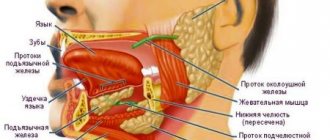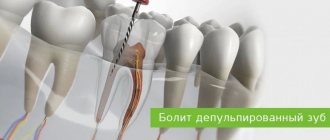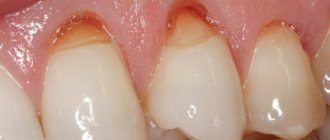If you have a toothache under a crown, do not panic - unpleasant sensations can occur immediately after a visit to the doctor and the installation of the structure itself.
Most likely, the pain will subside within 2-3 days. However, if a tooth begins to ache under a crown that was installed quite a long time ago, this is a reason to visit the doctor again. The possibilities of modern dentistry make it possible in most cases to save the tooth and the crown installed on it - the prognosis mainly depends on whether the “living” tooth hurts or whether it has already been depulped previously. There are several common reasons why a tooth hurts under a crown.
Causes of pain
As a rule, before installing a crown, the tooth is depulped - that is, the neurovascular bundle in the root and coronal part is removed, after which the canals are filled. Pain may be caused by some features of these manipulations:
- incomplete filling of the canals - as a result of the formation of voids in the root canals, an infectious process may begin to develop; Pus accumulates at the root tip, which causes pain. This is a common complication of endodontic treatment, especially in cases where the canals are too narrow or curved;
- subsidence of filling materials over time - even if the root canals are completely filled, changes in the physical properties of the materials can also lead to the appearance of voids - infection develops in them, inflammation spreads to the tissues near the apex of the tooth root;
- removal of the filling material beyond the root apex - “excess” material in the periodontal tissues can provoke irritation and inflammation.
Pulpitis. Inflammation of the pulp can occur in cases where a decision was made to preserve it - tooth processing can lead to a burn, the infectious process may already begin in the pulp and be asymptomatic, which becomes the cause of inflammation. Preserving living pulp before installing a crown on a tooth is a rare occurrence; as a rule, the “nerve” must be removed.
Perforation of the walls of the root canal. Perforation is the creation of a hole in the root canal, a phenomenon that occurs for several reasons:
- perforation may be a consequence of mechanical processing of the canal with a thin instrument - it must enter the canal along its entire length. If the canal is curved, then even a slight pressure can cause the instrument to pass through the tooth tissue;
- installation of a pin can lead to perforation - it is installed in the root canal, which, given the appropriate anatomical features of the structure of the root system, can also lead to the formation of a hole.
The hole is a “gateway” for infection—the tissue becomes inflamed some time after the pin is installed or endodontic treatment is performed, which causes pain.
Why does the tooth under the crown hurt?
The reason for this may be the presence of a foreign body in the canal. During endodontic treatment, the tip of the instrument may break off; subsequent filling of the canal with a foreign body leads to pain. There can be several reasons for breakage - the most common of them is the curvature of the canals. If they are difficult to pass, the tool may break due to the high load.
As a rule, in this case, the patient feels pain when exposed to temperatures, and the tooth under the crown also hurts when pressed. Pulsation may appear during exertion or chewing on the side with the crown installed. Tapping on a tooth also causes discomfort.
In order to avoid such a complication, the dentist must perform an x-ray diagnosis before installing a crown or any other dental prosthesis.
If the technology for processing and preparing the tooth for prosthetics is followed, installing a crown can also cause pain - if the design is too high for the bite, the patient feels discomfort when closing the jaws. This is why the stage of “trying on” the crown before its final installation is important - a good orthopedic dentist will first assess the degree of comfort for the patient.
Treatment methods
If a tooth without a nerve hurts under the crown, the specialist will determine the cause of the pain and apply the most appropriate treatment method. Most often, the artificial crown is removed, as it will interfere with the treatment. But sometimes specialists carry out therapy without removing the structure. A small hole is made on the chewing surface of the tooth and crown through which treatment procedures are carried out. Depending on the clinical situation and the cause of tooth pain under the crown, treatment tactics may be as follows:
- Removing the crown and making a new one. The doctor eliminates the inflammatory process, treats and re-seals the canals.
- Crown removal, treatment and re-fixation. If possible, after treatment, the doctor can install the same crown on the tooth. But this method is rarely used, since more often the structure is deformed during removal.
- Treatment through a crown. Treatment of lateral teeth in some cases can be carried out through the structure, provided there is good access.
- Removing the crown and performing tooth-preserving surgery. To preserve the tooth as a functional unit, operations are used that involve removing the source of inflammation with part of the tooth: hemisection (removal of one root), coronary-radicular separation (removal of half the tooth), resection of the apex (removal of the upper part of the root from the sites of inflammation, cyst) .
- Tooth extraction is a last resort measure of treatment, which is used when it is impossible to save the tooth with therapeutic methods.
A pulpless tooth hurts
If the pulp has been removed, the pain is most often aching. It can radiate to the temple or ear. The main reason for this phenomenon is the exacerbation of chronic periodontitis. The choice of therapy method is determined by the presence or absence of a pin in the tooth root canal:
- there is no pin: the doctor opens the crown, unseals the root canals and treats them properly, after which he places materials impregnated with antibacterial agents into the tooth. Several changes to the medication may be required until complete relief is obtained and the inflammatory process is eliminated. After the symptoms have completely subsided, the canals are filled again and a new crown is installed;
- there is a pin: the doctor can cure periodontitis through surgery - resection of the apex of the tooth root. It is performed through a small incision in the gum, through which the source of infection is removed, and if necessary, the resulting void is filled with osteoplastic material. Typically, the intervention lasts from 30 to 60 minutes and is well tolerated by patients.
Materials for making crowns
Modern dental crowns are made from:
- Metal.
Metal dentures are considered obsolete due to their lack of aesthetics, but are still used because they are the cheapest option; - Metal ceramics.
A relatively inexpensive and durable option, but due to the metal base it is difficult to achieve a “healthy” whiteness of an artificial tooth; - Ceramics.
Ceramic crowns are more aesthetically pleasing than metal-ceramics, but are inferior in strength, so they are usually installed only on the front teeth; - Porcelain.
A type of ceramic crown. Porcelain dentures are indistinguishable from living teeth, since the optical properties of the material are almost identical to tooth enamel. They are also installed on the front teeth; - Zirconia.
They are made on the basis of zirconium dioxide and covered with ceramics on top. Durable, aesthetic, but quite expensive crowns.
Zirconium dentures can be installed on any tooth.
The material, contrary to popular belief, does not cause toothache, but may be the answer to the question of why the gums hurt after installing a crown. Inflammation of the mucous membrane and gums can cause an allergic reaction to the metal in a metal-containing crown. Patients with ceramic and zirconium prostheses do not encounter such problems.
Gum pain
If the gums hurt, and not the tooth itself with a crown installed, there may be a deformation of the crown or a discrepancy in its size - the gums are mechanically damaged, which leads to inflammation and pain. For example, the edge of the crown extends under the gum or, on the contrary, does not reach its edge significantly - in the first case, a sharp edge can lead to soft tissue injury and inflammation. Moreover, it is worth noting that the pain can radiate into the tooth itself, which makes self-diagnosis difficult - the patient simply does not understand that it is the gums that hurt, and not the tooth under the crown.
If the crown does not reach the edge of the gum, the tooth under the crown hurts greatly - but not immediately after installation, but after quite a long time. The retention of food debris between the edge of the structure and the gum leads to the proliferation of pathogenic bacteria, the development of caries, and the destruction of tooth tissue under the crown. This leads to severe pain, tooth reactions to temperature, stress, etc.
The doctor’s tactics in this case is to remove the unsuitable crown; this is the only measure that a specialist can take to eliminate the problem.
If the gums are swollen, and even more so in cases where there is swelling of the cheek, there is most likely inflammation in the area of the apex of the tooth root. As a rule, swelling forms in the projection of the apex of the root of the causative tooth. You cannot do without a visit to a dentist - he will decide on the choice of treatment method taking into account the condition, structural features of the dental system, and the severity of the disease.
A fistula on the gum often forms a certain time after the appearance of swelling. This happens because the pus accumulated at the apex of the root requires release - after its outflow is established, the symptoms may subside, but this does not mean that the disease has passed. In this case, a visit to the doctor is mandatory - it is important to treat the disease and prevent possible complications.
Pain caused by the patient
Since the prosthesis is not a natural fabric, many people mistakenly believe that no maintenance is required. In this regard, an inflammatory process may occur. Therefore, in order to avoid such problems, you should adhere to several rules of hygiene.
Dentures are not natural fabrics; they cannot become inflamed or “sick” with caries. Therefore, some patients begin to neglect the rules of hygiene and wearing dentures, which, of course, is fraught with complications. Why this happens:
- lack of hygiene;
- non-compliance with nutrition rules.
Failure to maintain oral hygiene leads to inflammatory processes. Food debris in the form of a soft coating settles on the walls of the oral cavity and gets stuck in the gum area. Subsequently, the white plaque transforms into tartar and caries as a result.
After installing a prosthesis, you should try to limit yourself in food. After all, eating nuts and other solid foods can damage the prosthesis. In terms of strength, denture materials are stronger than enamel, but dentures should not be heavily loaded, because the slightest damage can open access for microbes to the internal tissue, and forceful loads on the root can lead to tooth loss.
When is pain normal?
Even a perfectly installed crown can provoke painful sensations immediately after prosthetics - as the local anesthesia wears off. The pain may be constant or occur with pressure. How to distinguish these sensations from those caused by pathology?
Firstly, pain normally lasts no more than 1-3 days - this is due to the adaptation of tissues to the new structure in the oral cavity.
Secondly, the pain tends to subside. Increasing sensations indicate a pathological process.
Frequent symptoms
The problem under consideration can manifest itself in different ways. However, there is a list of common symptoms that can help determine whether you should see a doctor:
If there is an inflammatory process, the patient experiences pain when pressing on the metal-ceramic crown or when biting in this area. This may mean that the gums under the crown are inflamed. Aching pain in the area of installation - in the presence of pus in the periodontal tissue, pressure increases and pain appears.
Swollen gums indicate a large amount of pus, a serious inflammatory process. Flux is accompanied by an increase in body temperature - it rises from 38 degrees and above. The patient may also feel echoes of pain in the head, temples, eyes, ears, teeth may randomly close and knock against each other.
An unpleasant odor under the crown also appears due to the presence of pus, a fistula (a fistula tract that allows pus to escape) or a cyst.
How to help yourself if the tooth under the crown hurts?
A tooth hurts under a crown - how to relieve the discomfort? It is important to make an appointment with a doctor first. Painkillers can be used as temporary measures, but you should consult with your doctor about the advisability of their use. It will not be possible to eliminate the cause of the pain at home - you can only alleviate the symptom a little.
You can resort to rinsing the mouth with warm water, in which 1 tsp was previously diluted. salt. A weak decoction of chamomile can also be used after first checking the temperature of the product - it should be room temperature.
Avoid heating the diseased tooth - hot compresses can lead to complications. Also, you should not apply “burning” products like garlic to the gums - you can get a burn to the mucous membrane.
What to do at home?
If a tooth with a crown hurts, then you need to quickly visit a specialist - a dentist. Before visiting a doctor, you can take the following measures:
- Take a pain reliever. It is better to use medications from the group of non-steroidal anti-inflammatory drugs - Paracetamol, Nimesil, Ibuprofen, Tempalgin, Ketanov;
- Carefully carry out hygienic cleaning of teeth and interdental spaces;
- Rinse the mouth with decoctions of medicinal herbs;
- Rinse with a salt-soda solution every 1-2 hours. To prepare the solution, you need to dissolve 1 teaspoon of salt and soda in 200 ml of boiled, slightly cooled water.
How to prevent pain?
Prevention of toothache under a crown includes following your doctor’s recommendations: crowns should be brushed just like your own teeth - at least 2 times a day. It is worth paying special attention to cleaning the spaces between the teeth and around the gums - this is where the largest amount of food debris and plaque accumulates. It is recommended to use not only a toothbrush and toothpaste, but also dental floss and, if possible, an irrigator.
You will have to refrain from eating solid foods - seeds, nuts, in order to avoid damage to the crown.
Visit your dentist at least once a year to monitor the quality of your dentures.











